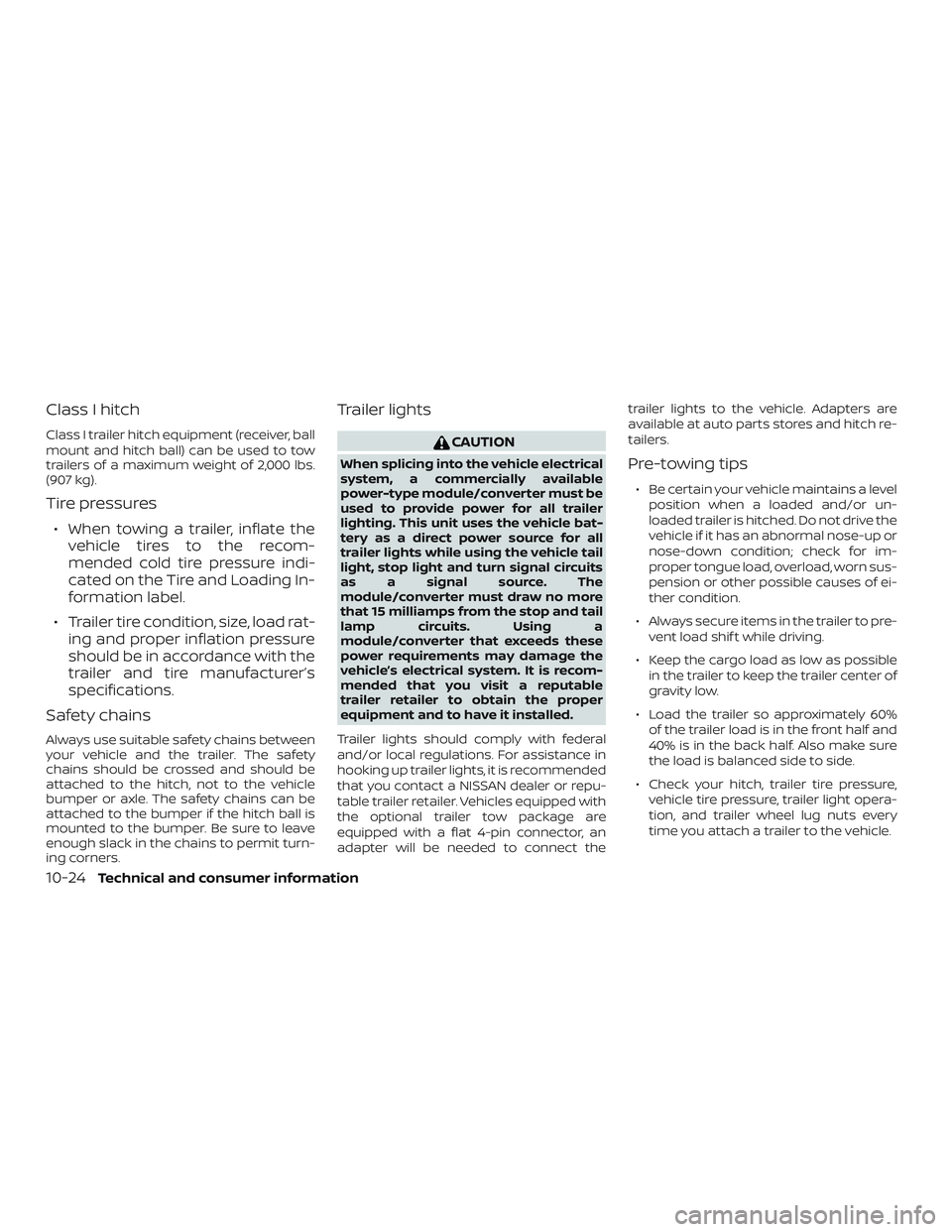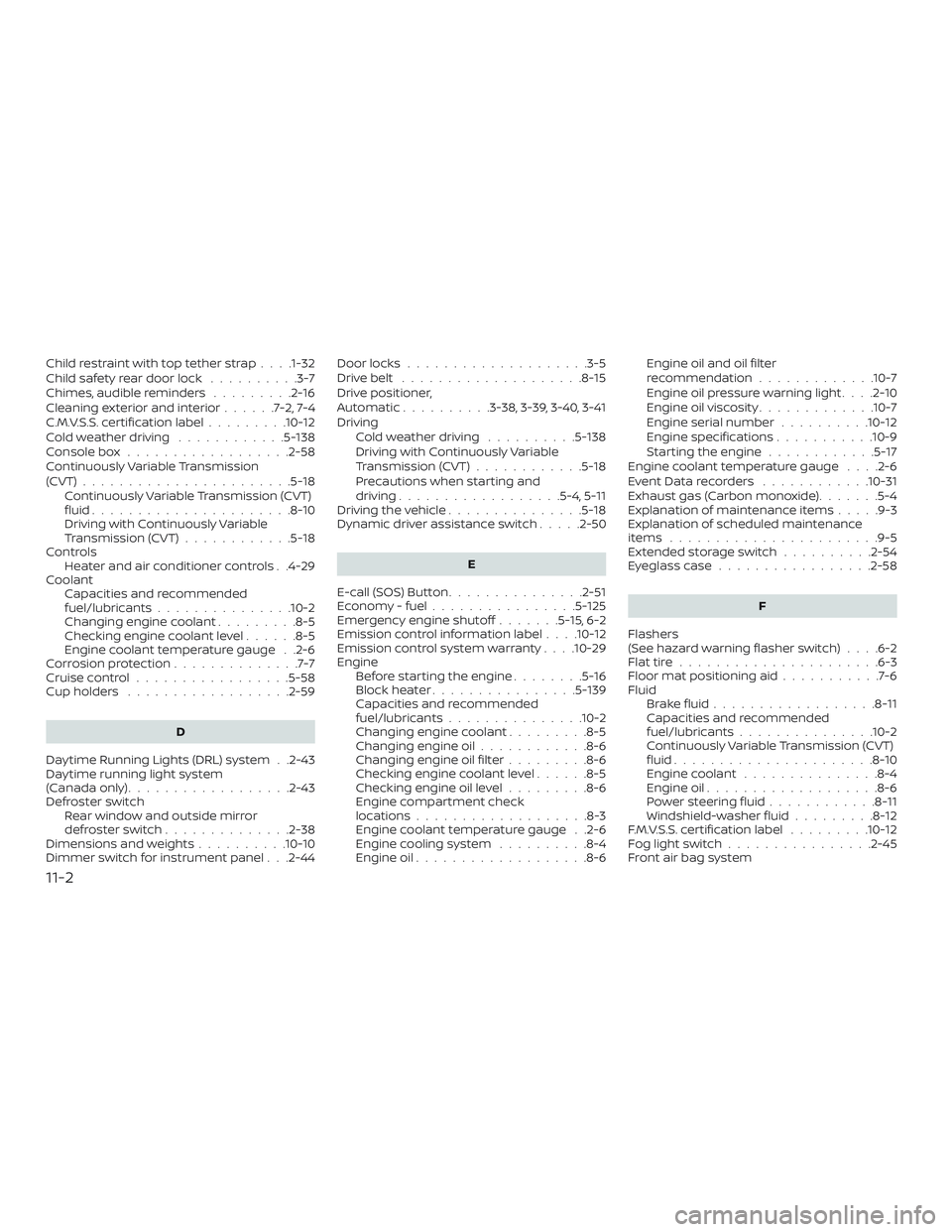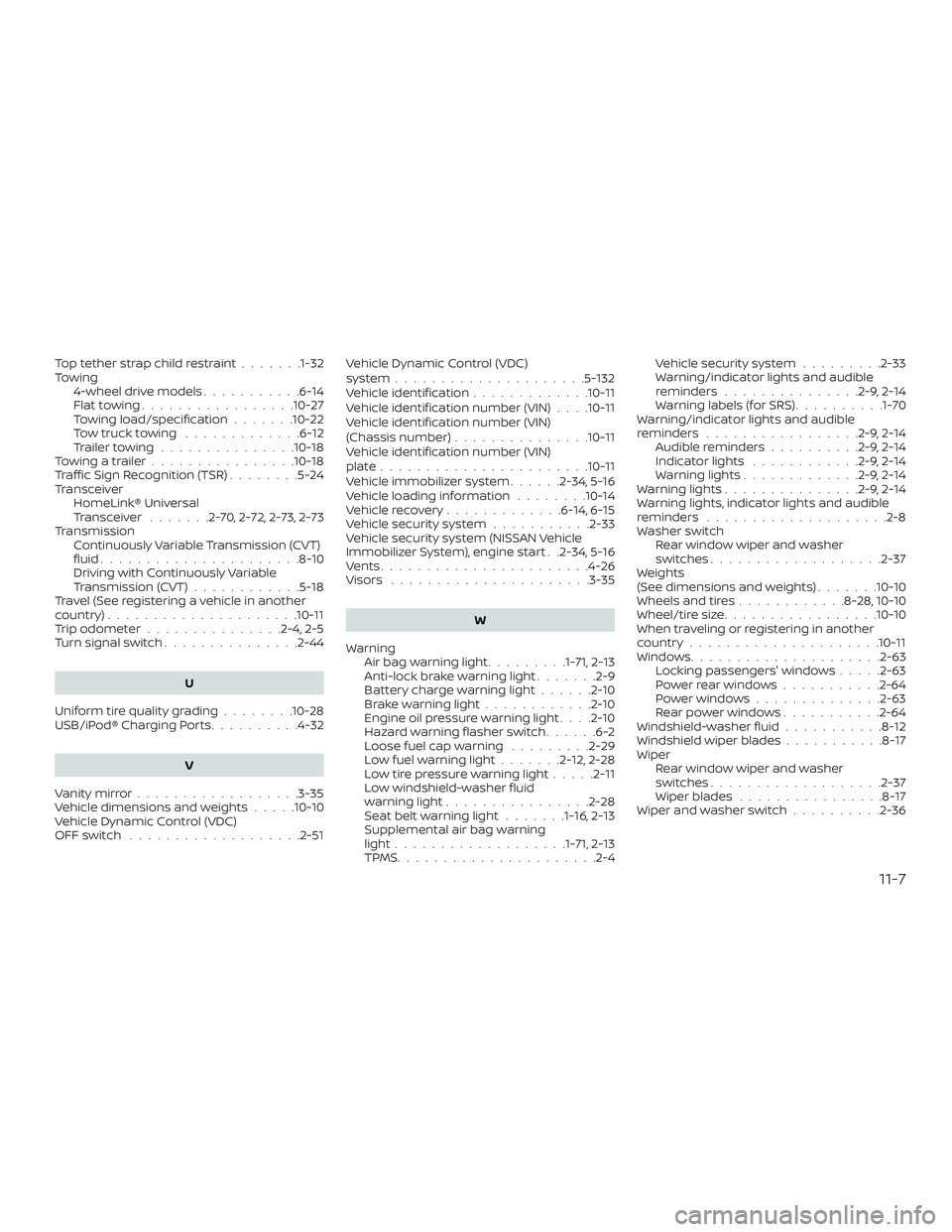2019 NISSAN MURANO weight
[x] Cancel search: weightPage 490 of 507

Class I hitch
Class I trailer hitch equipment (receiver, ball
mount and hitch ball) can be used to tow
trailers of a maximum weight of 2,000 lbs.
(907 kg).
Tire pressures
∙ When towing a trailer, inflate thevehicle tires to the recom-
mended cold tire pressure indi-
cated on the Tire and Loading In-
formation label.
∙ Trailer tire condition, size, load rat- ing and proper inflation pressure
should be in accordance with the
trailer and tire manufacturer’s
specifications.
Safety chains
Always use suitable safety chains between
your vehicle and the trailer. The safety
chains should be crossed and should be
attached to the hitch, not to the vehicle
bumper or axle. The safety chains can be
attached to the bumper if the hitch ball is
mounted to the bumper. Be sure to leave
enough slack in the chains to permit turn-
ing corners.
Trailer lights
CAUTION
When splicing into the vehicle electrical
system, a commercially available
power-type module/converter must be
used to provide power for all trailer
lighting. This unit uses the vehicle bat-
tery as a direct power source for all
trailer lights while using the vehicle tail
light, stop light and turn signal circuits
as a signal source. The
module/converter must draw no more
that 15 milliamps from the stop and tail
lamp circuits. Using a
module/converter that exceeds these
power requirements may damage the
vehicle’s electrical system. It is recom-
mended that you visit a reputable
trailer retailer to obtain the proper
equipment and to have it installed.
Trailer lights should comply with federal
and/or local regulations. For assistance in
hooking up trailer lights, it is recommended
that you contact a NISSAN dealer or repu-
table trailer retailer. Vehicles equipped with
the optional trailer tow package are
equipped with a flat 4-pin connector, an
adapter will be needed to connect the trailer lights to the vehicle. Adapters are
available at auto parts stores and hitch re-
tailers.Pre-towing tips
∙ Be certain your vehicle maintains a level
position when a loaded and/or un-
loaded trailer is hitched. Do not drive the
vehicle if it has an abnormal nose-up or
nose-down condition; check for im-
proper tongue load, overload, worn sus-
pension or other possible causes of ei-
ther condition.
∙ Always secure items in the trailer to pre- vent load shif t while driving.
∙ Keep the cargo load as low as possible in the trailer to keep the trailer center of
gravity low.
∙ Load the trailer so approximately 60% of the trailer load is in the front half and
40% is in the back half. Also make sure
the load is balanced side to side.
∙ Check your hitch, trailer tire pressure, vehicle tire pressure, trailer light opera-
tion, and trailer wheel lug nuts every
time you attach a trailer to the vehicle.
10-24Technical and consumer information
Page 491 of 507

∙ Be certain your rearview mirrors con-form to all federal, state or local regula-
tions. If not, install any mirrors required
for towing before driving the vehicle.
∙ Determine the overall height of the ve- hicle and trailer so the required clear-
ance is known.
Trailer towing tips
In order to gain skill and an understanding
of the vehicle’s behavior, you should prac-
tice turning, stopping and backing up in an
area which is free from traffic. Steering sta-
bility and braking performance will be
somewhat different than under normal
driving conditions.
∙ Always secure items in the trailer to pre- vent load shif t while driving.
∙ Lock the trailer hitch coupler with a pin or lock to prevent the coupler from in-
advertently becoming unlatched.
∙ Avoid abrupt starts, acceleration or stops.
∙ Avoid sharp turns or lane changes.
∙ Always drive your vehicle at a moderate speed. ∙ When backing up, hold the bottom of
the steering wheel with one hand. Move
your hand in the direction in which you
want the trailer to go. Make small cor-
rections and back up slowly. If possible,
have someone guide you when you are
backing up.
Always block the wheels on both vehicle
and trailer when parking. Parking on a
slope is not recommended; however, if you
must do so:
CAUTION
If you move the shif t lever to the P (Park)
position before blocking the wheels
and applying the parking brake, trans-
mission damage could occur.
1. Apply and hold the brake pedal.
2. Have someone place blocks on the downhill side of the vehicle and trailer
wheels.
3. Af ter the wheel blocks are in place, slowly release the brake pedal until the
blocks absorb the vehicle load.
4. Apply the parking brake.
5. Shif t the transmission into P (Park).
6. Turn off the engine. To drive away:
1. Start the vehicle.
2. Apply and hold the brake pedal.
3. Shif t the transmission into gear.
4. Release the parking brake.
5. Drive slowly until the vehicle and trailer are clear from the blocks.
6. Apply and hold the brake pedal.
7. Have someone retrieve and store the blocks.
∙ While going downhill, the weight of the trailer pushing on the tow vehicle may
decrease overall stability. Therefore, to
maintain adequate control, reduce your
speed and shif t to a lower gear. Avoid
long or repeated use of the brakes
when descending a hill, as this reduces
their effectiveness and could cause
overheating. Shif ting to a lower gear in-
stead provides “engine braking” and re-
duces the need to brake as frequently.
∙ If the engine coolant temperature rises to a high temperature, refer to “If your
vehicle overheats” in the “In case of
emergency” section of this owner’s
manual.
Technical and consumer information10-25
Page 500 of 507

Child restraint with top tether strap . . . .1-32
Child safety rear door lock..........3-7
Chimes, audible reminders .........2-16
Cleaningexteriorandinterior......7-2,7-4
C.M.V.S.S. certification label .........10-12
Coldweatherdriving ............5-138
Console box ..................2-58
Continuously Variable Transmission
(CVT) .......................5-18
Continuously Variable Transmission (CVT)
fluid......................8-10
Driving with Continuously Variable
Transmission (CVT) ............5-18
Controls Heater and air conditioner controls . .4-29
Coolant Capacities and recommended
fuel/lubricants...............10-2
Changing engine coolant .........8-5
Checking engine coolant level ......8-5
Engine coolant temperature gauge . .2-6
Corrosionprotection..............7-7
Cruisecontrol.................5-58
Cupholders ..................2-59
D
Daytime Running Lights (DRL) system . .2-43
Daytime running light system
(Canada only) ..................2-43
Defroster switch Rear window and outside mirror
defrosterswitch..............2-38
Dimensions and weights ..........10-10
Dimmer switch for instrument panel . . .2-44 Door locks
....................3-5
Drivebelt ....................8-15
Drive positioner,
Automatic..........3-38,3-39,3-40,3-41
Driving Cold weather driving ..........5-138
Driving with Continuously Variable
Transmission (CVT) ............5-18
Precautions when starting and
driving..................5-4,5-11
Drivingthevehicle...............5-18
Dynamic driver assistance switch .....2-50
E
E-call (SOS) Button ...............2-51
Economy - fuel ................5-125
Emergency engine shutoff .......5-15,6-2
Emission control information label . . . .10-12
Emission control system warranty . . . .10-29
Engine Before starting the engine ........5-16
Blockheater................5-139
Capacities and recommended
fuel/lubricants...............10-2
Changing engine coolant .........8-5
Changing engine oil ............8-6
Changing engine oil filter .........8-6
Checking engine coolant level ......8-5
Checking engine oil level .........8-6
Engine compartment check
locations...................8-3
Engine coolant temperature gauge . .2-6
Engine cooling system ..........8-4
Engine oil ...................8-6 Engine oil and oil filter
recommendation
.............10-7
Engine oil pressure warning light . . . .2-10
Engine oil viscosity .............10-7
Engine serial number ..........10-12
Engine specifications ...........10-9
Starting the engine ............5-17
Engine coolant temperature gauge ....2-6
EventDatarecorders ............10-31
Exhaust gas (Carbon monoxide) .......5-4
Explanation of maintenance items .....9-3
Explanation of scheduled maintenance
items .......................9-5
Extended storage switch ..........2-54
Eyeglasscase.................2-58
F
Flashers
(Seehazardwarningflasherswitch)....6-2
Flattire......................6-3
Floormatpositioningaid...........7-6
Fluid Brakefluid..................8-11
Capacities and recommended
fuel/lubricants...............10-2
Continuously Variable Transmission (CVT)
fluid......................8-10
Engine coolant ...............8-4
Engine oil ...................8-6
Powersteeringfluid............8-11
Windshield-washer fluid .........
8-12
F.M.V.S.S. certification label .........10-12
Foglightswitch................2-45
Front air bag system
11-2
Page 505 of 507

Toptetherstrapchildrestraint.......1-32
Towing4-wheel drive models ...........6-14
Flattowing.................10-27
Towing load/specification .......10-22
Towtrucktowing .............6-12
Trailertowing...............10-18
Towingatrailer................10-18
Traffic Sign Recognition (TSR) ........5-24
Transceiver HomeLink® Universal
Transceiver .......2-70,2-72,2-73,2-73
Transmission Continuously Variable Transmission (CVT)
fluid......................8-10
Driving with Continuously Variable
Transmission (CVT) ............5-18
Travel (See registering a vehicle in another
country) .....................10-11
Trip odometer ...............2-4,2-5
Turn signal switch ...............2-44
U
Uniform tire quality grading ........10-28
USB/iPod® Charging Ports ..........4-32
V
Vanitymirror..................3-35
Vehicle dimensions and weights .....10-10
Vehicle Dynamic Control (VDC)
OFFswitch ...................2-51 Vehicle Dynamic Control (VDC)
system
.....................5-132
Vehicle identification .............10-11
Vehicle identification number (VIN) . . . .10-11
Vehicle identification number (VIN)
(Chassis number) ...............10-11
Vehicle identification number (VIN)
plate.......................10-11
Vehicle immobilizer system ......2-34,5-16
Vehicle loading information ........10-14
Vehiclerecovery.............6-14,6-15
Vehicle security system ...........2-33
Vehicle security system (NISSAN Vehicle
Immobilizer System), engine start . .2-34, 5-16
Vents.......................4-26
Visors ..................... .3-35
W
Warning Airbagwarninglight.........1-71, 2-13
Anti-lock brake warning light .......2-9
Battery charge warning light ......2-10
Brakewarninglight............2-10
Engine oil pressure warning light ....2-10
Hazard warning flasher switch ......6-2
Loose fuel cap warning .........2-29
Lowfuelwarninglight.......2-12,2-28
Lowtirepressurewarninglight.....2-11
Low windshield-washer fluid
warninglight................2-28
Seatbeltwarninglight.......1-16, 2-13
Supplemental air bag warning
light.................. .1-71, 2-13
TPMS......................2-4 Vehicle security system
.........2-33
Warning/indicator lights and audible
reminders ...............2-9,2-14
Warning labels (for SRS) ..........1-70
Warning/indicator lights and audible
reminders .................2-9,2-14
Audible reminders ..........2-9,2-14
Indicatorlights ............2-9,2-14
Warninglights.............2-9, 2-14
Warninglights...............2-9,2-14
Warning lights, indicator lights and audible
reminders ....................2-8
Washer switch Rear window wiper and washer
switches ...................2-37
Weights
(See dimensions and weights) .......10-10
Wheels and tires ............8-28,10-10
Wheel/tire size .................10-10
When traveling or registering in another
country .....................10-11
Windows.....................2-63 Locking passengers' windows .....2-63
Powerrearwindows...........2-64
Powerwindows..............2-63
Rearpowerwindows...........2-64
Windshield-washer fluid ...........8-12
Windshield wiper blades ...........
8-17
Wiper Rear window wiper and washer
switches ...................2-37
Wiper blades ................8-17
Wiper and washer switch ..........2-36
11-7